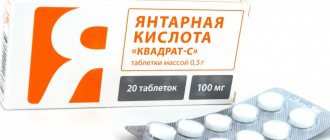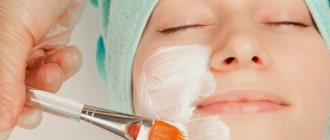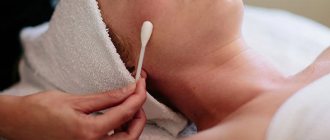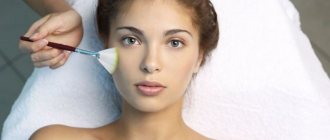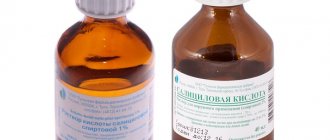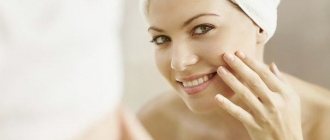Peeling with lactic acid is a good way to quickly tidy up your face, make it fresher, younger and more attractive. At the BL clinic, this type of peeling is performed using professional Ultraceuticals cosmetics. Our cosmetologists skillfully select rejuvenating procedures and carefully treat the skin, achieving remarkable aesthetic results.
Properties of lactic acid
Cosmetics manufacturers often use lactic acid (lactate) in cosmetics. It has a keratolytic effect (exfoliation), moisturizes and improves skin tone, has a sebum-regulating, bactericidal and anti-inflammatory effect.
Lactate is formed as a result of the breakdown of glucose and belongs to the category of α-hydroxy acids. When the substance gets on the surface of the skin, the process of exfoliation of its top layer starts. Thanks to this, it becomes soft and tender. After penetrating into the mouths of the sebaceous glands, lactate dissolves accumulated dirt, epithelium and cosmetic residues. This allows you to eliminate blackheads and avoid the development of inflammation. Lactic acid also contains lactathione, a natural antiseptic that slows down the proliferation of pathogenic microorganisms.
Lactic acid penetrates deeply into cell membranes and promotes the uniform distribution of active substances that nourish the skin from the inside. It is sometimes added to homemade nourishing masks for the face and body. But here it is important to maintain the correct concentration. The acid content in the mask should be minimal. But for peeling, a highly concentrated composition is used. It is absolutely safe for the skin.
Among the beneficial properties of lactic acid are:
- Stimulating active renewal of dermal cells;
- Acceleration of collagenase processes (formation of new collagen fibers);
- Improving blood circulation in the area of cosmetic procedures;
- Whitening areas of pigmentation;
- Moisturizing the upper layers of the skin;
- Activation of the epidermis’s own protective properties.
Types of superficial body peelings
The frequency of body skin peeling procedures depends on its type: for dry skin - once every two weeks, for normal skin - once a week, for oily skin - twice a week. The required number of procedures will be prescribed by a cosmetologist.
The duration of one procedure is usually 20-30 minutes. Regardless of the type of peeling performed, the skin of the body will need to be moisturized, that is, peeling should be supplemented with wrapping procedures, applying masks or creams.
Mineral peels
The skin is cleansed with the help of minerals: sea or mountain salt, sea sand, volcanic and sea mud, clay. The peeling composition is often supplemented with seaweed paste, plant extracts, and essential oils.
Mineral peels have a detoxifying effect on the skin - the removal of toxins is stimulated by improved blood and lymph circulation; healing - the skin is saturated with vitamins and microelements; whitening - areas of hyperpigmentation are lightened by removing the top layer of skin; toning and strengthening - the structure of the skin becomes denser, its elasticity increases.
Honey-salt peeling
It is carried out both as an independent procedure that heals the skin of the body, and as a preparatory manipulation in figure correction programs: for weight loss and elimination of cellulite.
The main components of such peeling - mineral salt and honey - can be supplemented with herbal ingredients and essential oils. Microelements contained in salt (calcium, iron, iodine, etc.) and active substances in honey (natural antioxidants, phytoncides, vitamins) have a restorative effect on the skin.
Honey-salt peeling, in addition to effectively cleansing the skin, moisturizes and nourishes it, saturates it with minerals, improves metabolism, and increases turgor.
Peeling with black soap
This type of peeling is included in the list of services of many beauty salons and SPA centers and is part of many figure correction and body skin restoration programs.
Black soap is made from eucalyptus and olive tree plant materials and contains many active substances: vitamins and antioxidants. Peeling with black soap deeply cleanses the skin, stimulates tissue renewal, has an antiseptic effect, the aroma of eucalyptus relieves tension and fights stressful conditions.
Herbal peelings
Herbal peels can be of different consistency - gel, cream, paste. The exfoliating effect occurs due to the content of particles of fruit or berry seeds (grapes, apricots, coconuts and others).
Additionally, herbal peelings often include wax, cane sugar, rice flour, and vegetable oils. In addition to the skin-healing effect, peelings with herbal ingredients well prepare the skin for further care or correction procedures.
Advantages and features of peeling
Milk peeling Argipeel (Argipil) is suitable even for the most sensitive skin. But this is far from the only advantage of this procedure:
- The recovery period is minimal; there will be virtually no signs of peeling on the surface of the skin after the procedure;
- Lactic acid does not cause allergies in the patient, the only exception may be its individual intolerance;
- Peeling is allowed even in summer;
- No preliminary preparation is required, just cleanse the skin of impurities and you can begin the procedure;
- Peeling additionally moisturizes the skin and makes it more elastic;
- The procedure is safe even for dark skin; no special care products are required.
Lactic acid goes well with other ingredients. If necessary, a cosmetologist can individually select a peeling composition that will transform it from superficial to medium. This means that not only the top layer of skin - the dermis, but also the epidermis will be exposed.
The only drawback of milk peeling is its low effectiveness for mature skin.
Effects of body peeling procedure
After the first session, you will notice how the skin color in the treated area has improved and its texture has evened out. Over time, the result will improve and include: alignment of skin texture and color; lifting effect; lymphatic drainage; cleansing and reducing pores; stimulation of elastin and collagen synthesis; stimulation of your own skin renewal processes. To achieve a complete and lasting result, the number of body peeling sessions is calculated individually and depends on the characteristics of the patient, the nature of the problems, their duration and degree of complexity. As the practice of our doctors shows, to obtain an amazing and long-lasting result, you need to complete a course of at least 4 procedures. Body peeling makes it possible not only to solve the problem of aesthetic skin defects, but also to have a complex stimulating effect on the body. It helps improve skin respiration, increases skin turgor, its smoothness and moisture, and eliminates swelling. In addition, the technique also gives a charge of vivacity, good mood, a feeling of lightness and vitality.
Indications for the procedure
Milk chemical peeling is recommended for patients under the age of 35-40 years.
Indications for the procedure include:
- Unhealthy, dull complexion;
- Freckles and mild age spots;
- Acne and hyperkeratosis;
- Excessive secretion of sebum from the pores;
- Small expression wrinkles in the area around the eyes or mouth;
- Enlarged pores;
- Fresh stretch marks;
- Dry and dehydrated skin.
Milk peeling is often used as a preliminary preparation for other cosmetic procedures. It is optimally suited for the face and décolleté; on other parts of the body it can be used as an effective remedy in complex therapy against scars.
How to peel with lactic acid
No special preparation is required for peeling. But it is recommended to limit exposure to the sun 2 weeks before the procedure - do not sunbathe. For patients with pronounced skin problems and very delicate skin, a cosmetologist may recommend daily use of a cream containing lactic or fruit acid.
The peeling procedure consists of the following steps:
- The skin is cleansed of impurities and decorative cosmetics. A special lotion is used. The skin is disinfected. To soften exfoliated particles of the epidermis, a small amount of the drug with the active ingredient in a minimum concentration is applied to the skin.
- Concentrated lactic acid is applied in two stages. It should remain on the surface of the skin for 10 to 40 minutes. The concentration of the drug is selected individually depending on the type of cosmetic problems and the general condition of the patient’s skin. Sensitivity and skin type are also taken into account.
- The cosmetologist must monitor the progress of the procedure. If the slightest signs of burns appear, the solution is immediately neutralized. If there are no side effects, it is possible to use more concentrated solutions during the next peeling. Peeling does not cause pain; the maximum that can be felt is a slight burning sensation in the first minutes after applying the acid.
- After the scheduled time, the drug is washed off from the skin. A moisturizing composition is applied to it; this can be a well-proven alginate mask. After its removal, the skin is treated with a nourishing cosmetic cream.
A repeat session of the procedure can be performed after 14-20 days.
Which peeling to choose - the opinion of a cosmetologist
Peeling
(from English to peel in translation means - to remove the peel, to clean) - one of the methods of removing the top layer of skin, which helps to renew the underlying layers.
Depending on the depth of impact, peelings are divided into superficial, medium and deep. There are several types of peeling: chemical, laser, mechanical, plasma. The most affordable and effective is chemical peeling. α - hydroxy acids (glycolic, lactic, tartaric, citric, etc.) and β - hydroxy acids (salicylic, etc.) are most often used as a chemical agent in peelings.
These acids have the following effects: exfoliating effect; influence on the barrier function of the stratum corneum, which manifests itself in strengthening this function by stimulating the synthesis of ceramides; moisturizing effect, which is associated with the removal and renewal of the epidermis, which leads to an increase in natural moisturizing factor (NMF); anti-inflammatory and antioxidant effect, which is carried out through influencing inflammatory mediators and increasing local immunity; enhancing the synthesis of collagen and glycosaminoglycans by stimulating the function of fibroblasts, which contributes to the thickening and compaction of the dermis.
Common types of peeling
Glycolic peeling.
The main ingredient of a glycolic peel is glycolic acid. Glycolic acid has a small molecule, so it easily penetrates the epidermal barrier and has the most pronounced effect. When choosing this type of peeling, such indicators as the pH concentration of the solution are important. Exfoliating activity, changes in the dermis, stimulation of collagen and glycosaminoglycan synthesis depend on these indicators. Using this type of peeling we get the following effects: exfoliation, anti-inflammatory, antibacterial, comedolytic effects, skin texture and color improve, pores narrow and acne scars are smoothed out. However, rapid and uneven penetration may be accompanied by the development of irritation and a burning sensation.
Salicylic peeling.
Salicylic acid is often used as an auxiliary transport system. However, salicylic acid itself can be used as an independent ingredient. It is effective in the fight against acne, prevention of inflammatory elements and has a keratolytic effect in the treatment of dermatoses accompanied by hyperkeratinization (seborrheic dermatitis, psoriasis, ichthyosis, atopic dermatitis). It has the following effects: evens out the relief; anti-inflammatory effect; comedolytic; antibacterial; exfoliating. In addition, salicylic acid softens dry, rough and flaky skin.
Almond peeling.
Mandelic acid has a larger particle than glycolic acid, therefore it penetrates the skin more slowly and evenly, produces all the effects characteristic of glycolic acid, but does not irritate the skin and is ideal for those with sensitive skin. And its antimicrobial activity allows it to be used for more severe forms of acne and hyperpigmentation. It is characterized by the following effects: anti-inflammatory; antibacterial; improves the relief of the skin; depigmenting; reduction in the thickness of the stratum corneum.
Retinoic peeling or yellow.
The active ingredient is retinol. Stimulates the growth and proliferation of basal kerotinocytes and fibroblasts, accelerates cellular renewal of the epidermis and stimulates collagen formation. Due to the inclusion of whitening components, it has a depigmenting effect. Indications for yellow peeling: epidermal melasma (pigmentation); pigmented superficial moles; superficial wrinkles; seborrhea; consequences of acne. During the post-peeling period, severe peeling is characteristic, and manifestations of aseptic inflammation are possible. Contraindicated during pregnancy, lactation, and liver dysfunction.
TCA peeling.
The active principle is trichloroacetic acid. It is used for superficial and medium peeling, accompanied by a pronounced burning sensation and painful procedure. In the post-peeling period, large-plate peeling and hyperemia are noted. Contraindicated during pregnancy and lactation. Effects: stimulating effect on fibroblasts and stimulation of neocollagenogenesis; pronounced leveling effect; comedolytic effect; reducing the depth of wrinkles, the effect of “shrinking” the skin. However, this peeling must be approached very responsibly so that complications do not arise.
Contraindications typical for any peeling
- Warts in the peeling area.
- Herpes in the active phase.
- Photos and solar dermatitis.
- Radiation therapy in connection with cancer.
- Pregnancy and lactation.
- Taking Roaccutane.
- Insolation in less than 2 days.
- Increased sensitivity to peeling components.
- Exacerbation of chronic skin diseases or acute dermatological disease.
- Decompensation of any somatic disease.
- Acute condition.
Which peeling to choose is best decided after consultation with a cosmetologist, who will also advise the frequency and duration of the course of peelings. The severity of the expected effect and the solution of the assigned tasks will depend on this. Best time for peeling
– this is autumn, winter and early spring.
Main tasks of post-peeling care
- Ensuring skin protection from UV radiation (cream with adequate SPF factor).
- Reduction of post-peeling skin reaction.
- Accelerate healing.
- Preventing complications.
For home post-peeling care, adequate and necessary cosmetic products should be selected, aimed at providing comfortable subjective sensations, preserving moisture in the skin, preventing complications and creating conditions for restoring the dermal layer.
In conclusion, I would like to note that peelings are extremely effective and safe in the hands of a specialist.
Make an appointment with specialists by calling a single call center:
+7(495)636-29-46 (metro stations “Schukinskaya” and “Street 1905 Goda”). You can also make an appointment with a doctor on our website, we will call you back!
Results and recovery period
The results of Argipil peeling, if performed by an experienced specialist using professional preparations, are visible almost after the first session:
- Small wrinkles on the skin are smoothed out;
- Age spots and freckles become dull and are no longer so pronounced;
- The skin looks healthier and more hydrated, no trace of dryness remains;
- The natural complexion returns, a slight lifting effect is observed;
- If there are post-acne spots on the skin, they are even in shade with other skin;
- Sebum production decreases significantly.
The first few days after a superficial peel, the skin may experience slight redness. During this period, the epidermis actively exfoliates; visually it is almost imperceptible, but a slight itching may be felt. It is advisable to give up not only decorative, but also skincare cosmetics for these few days. You can use various creams or lotions only after consulting a cosmetologist.
You should not use strong products for washing for about 4-5 days after peeling with lactic acid. They can provoke skin inflammation, which will be associated with the entry into the pores of aggressive chemicals that are part of most types of antibacterial soap.
Before going outside, especially if you plan to spend a long time in the sun, you need to use sunscreen. Avoid visiting solariums, saunas and public swimming pools where aggressive chemicals are used to purify the water.
TCA peeling
TCA peeling provides a pronounced rejuvenating effect, affecting deeper layers of the skin compared to superficial peeling. Despite the high effectiveness of this type of peeling, it is relatively low-traumatic and does not cause negative side effects. TCA peeling with trichloroacetic acid eliminates hyperpigmentation and significantly improves complexion, and has a pronounced lifting effect.
TCA peels can be used not only on small areas, such as to eliminate crow's feet around the mouth and eyes, but also on the entire face, as well as on the outside of the hands. Thanks to TCA peeling, the skin regains its youth - it becomes fresh, tightened, its structure is restored, age-related pigmentation is reduced, fine wrinkles are smoothed out, and some scars are evened out. The peeling procedure takes no more than 30 minutes. Already 5-7 days after TCA peeling, you can use makeup, and after 2-3 weeks, when traces of redness finally disappear, your skin will gain freshness, become young and beautiful. To achieve optimal results, 1-3 sessions with a break of 2-4 weeks are usually sufficient.
Contraindications
Argipeel peeling should not be carried out during periods of exacerbation of chronic or inflammatory diseases. It is prohibited for diagnosed oncology. It is recommended for pregnant and nursing mothers to temporarily postpone the procedure.
Other contraindications to superficial peeling include:
- damage to the skin at the site of the procedure;
- herpes;
- rosacea;
- lactic acid intolerance;
- taking antibiotics.
You should not do the procedure in the first week after hair removal. Some of the described contraindications are relative. Patients with herpes may be allowed the procedure, but before it they will have to take a course of antiviral drugs. The decision on the advisability of peeling in the presence of certain contraindications is made exclusively by a cosmetologist.
To obtain a lasting result, it is recommended to undergo 4-5 peeling sessions. The intensity and duration of the skin healing course is determined by the cosmetologist during an individual examination of the patient. Make an appointment with specialists at the Absolut Med Aesthetic Medicine Clinic right now!
